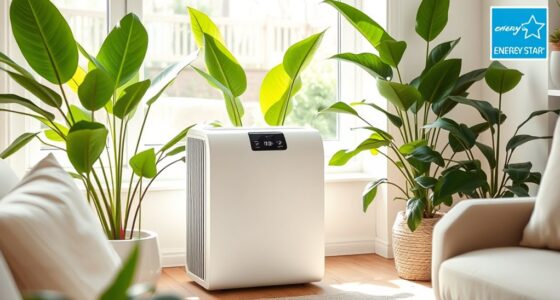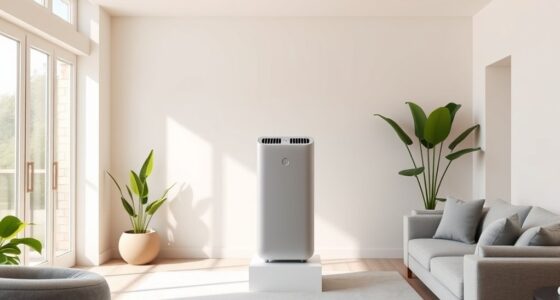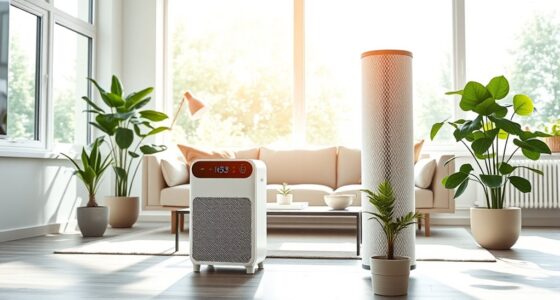H13 and H14 HEPA filters both effectively improve your indoor air quality, but H14 offers higher filtration efficiency, trapping at least 99.995% of particles as small as 0.3 microns, making it ideal for severe allergies and microbes. H13 filters provide a good balance of performance and ease of use for typical household needs. To find the right fit for your home and learn more about their differences, keep exploring the key factors to examine.
Key Takeaways
- H14 filters offer higher filtration efficiency (≥99.995% at 0.3 microns) compared to H13 filters (≈99.95%), capturing smaller particles and pathogens more effectively.
- H14 filters have higher airflow resistance, requiring more energy and more frequent replacements, leading to increased operational costs.
- H13 filters are more common, easier to install, and generally more compatible with household purifiers, while H14 may need specialized units.
- Both filters improve indoor air quality, but H14 provides superior removal of allergens, bacteria, and viruses for sensitive environments.
- Choosing between them depends on air quality needs, budget, and device compatibility, with H14 suited for higher contamination levels.
Understanding HEPA Filter Classifications and Standards
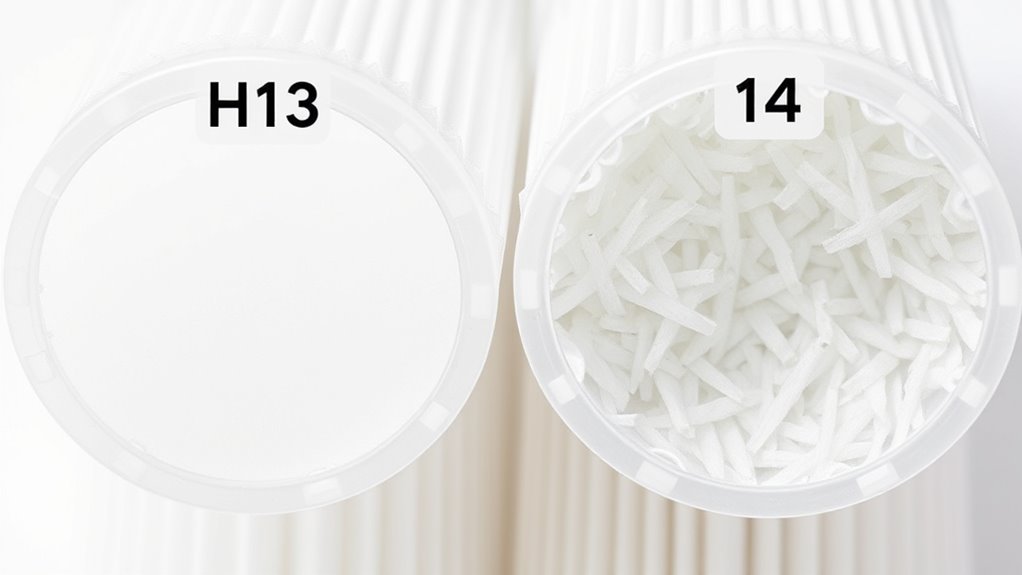
To understand the differences between H13 and H14 HEPA filters, it’s essential to grasp how these filters are classified and what standards they must meet. Both fall under the HEPA standard set by strict industry guidelines, ensuring high filtration levels. H13 filters typically offer a good balance of filter longevity and ease of installation, making them suitable for many household applications. H14 filters, however, generally provide enhanced performance with slightly more complex installation procedures. The classification indicates their ability to trap airborne particles, but it also hints at how long the filter will last before needing replacement. Understanding asset division laws helps you choose a filter that aligns with your needs for both longevity and installation convenience, ensuring effective air purification over time.
Filtration Efficiency: Comparing H13 and H14 Performance
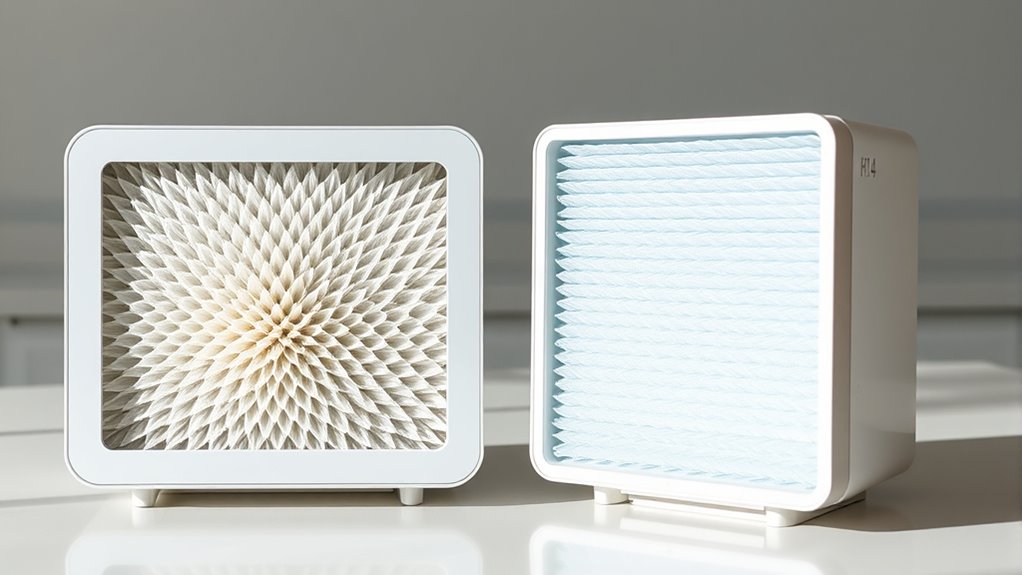
When it comes to filtration efficiency, H14 HEPA filters outperform H13 filters by capturing a higher percentage of airborne particles. This means your air purifier design becomes more effective at removing tiny pollutants like bacteria, viruses, and allergens. H14 filters can trap at least 99.995% of particles as small as 0.3 microns, compared to 99.95% for H13 filters. However, this higher efficiency may lead to increased filter replacement frequency, since H14 filters tend to clog faster with trapped particles. You’ll need to monitor and replace filters more often to maintain ideal performance. Ultimately, choosing between H13 and H14 depends on your air quality needs and how much maintenance you’re willing to perform for better filtration efficiency. Additionally, understanding filtration efficiency helps you make informed decisions about your indoor air quality and the long-term benefits of each filter type.
Common Uses and Applications in Household Environments
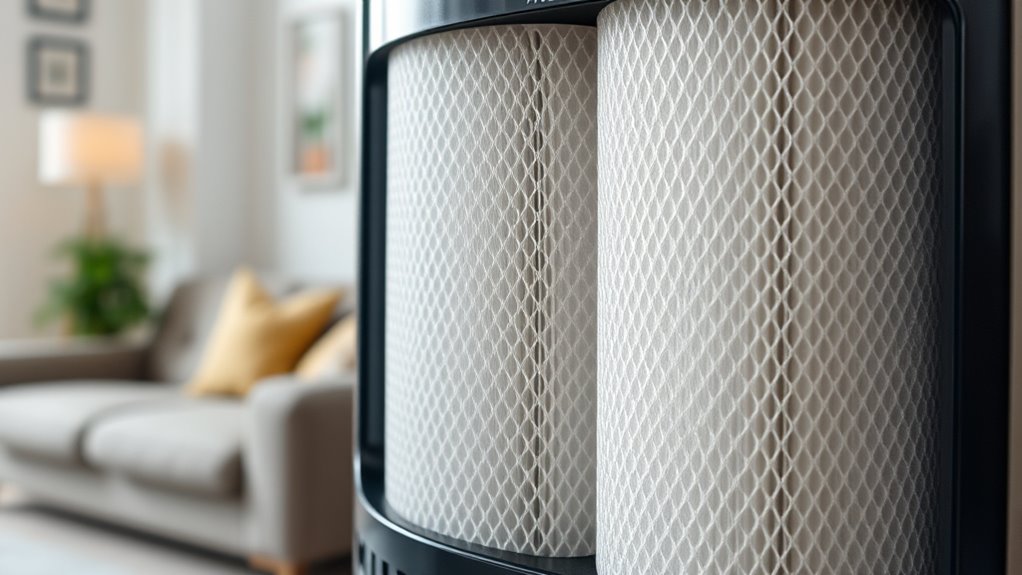
Are H13 and H14 HEPA filters suitable for various household environments? Absolutely. They’re ideal for bedrooms, living rooms, and home offices, where clean air matters most. These filters help reduce airborne particles, making them perfect for households with allergy sufferers or pets. To maintain peak performance, regular air purifier maintenance is essential. Follow filter replacement tips, such as checking manufacturer guidelines and replacing filters when airflow decreases or after a set period. H13 and H14 filters are versatile, fitting into many household purifiers to improve air quality. They’re especially useful in environments with dust, pet dander, or microorganisms, ensuring your indoor air stays fresh and safe. Proper filter maintenance and timely filter replacement maximize their benefits and prolong your purifier’s lifespan.
Effectiveness Against Allergens, Dust, and Microorganisms

H13 and H14 HEPA filters excel at capturing allergens, dust, and microorganisms, making them highly effective for improving indoor air quality. They efficiently trap airborne pathogens, reducing the risk of illness, and remove pet dander, alleviating allergy symptoms. These filters can capture particles as small as 0.1 microns, ensuring that microscopic allergens and bacteria are filtered out. This means you’re protected from common triggers like mold spores, pollen, and bacteria that circulate in your home. Both filter types considerably improve air purity, but H14 filters often provide a slightly higher level of filtration, making them ideal for households with severe allergies or respiratory conditions. Additionally, understanding the contrast ratio of filters can help determine their effectiveness in different environments. Overall, these HEPA filters help create a cleaner, healthier living environment by removing a wide range of airborne contaminants.
Airflow Resistance and Maintenance Requirements
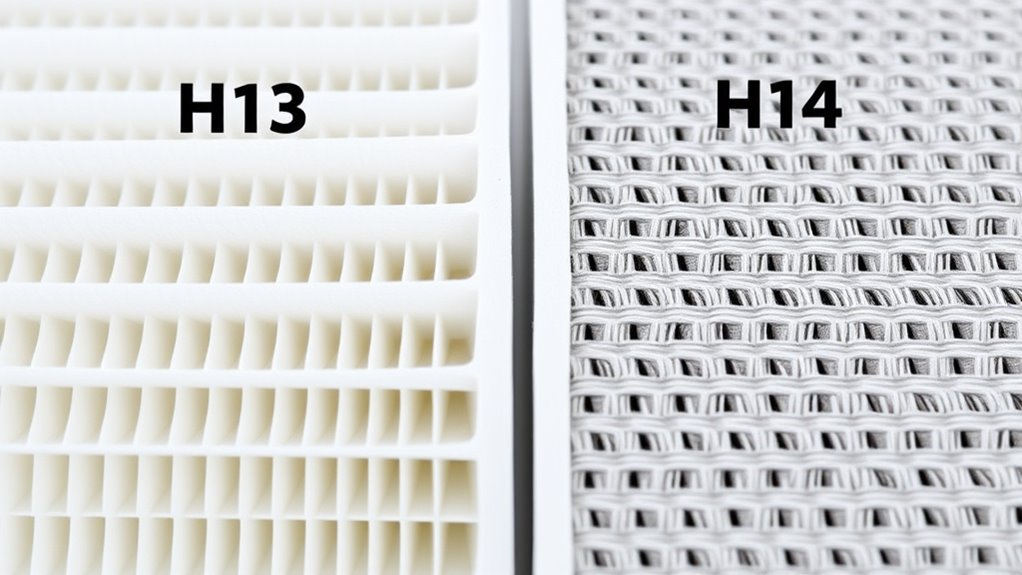
While both H13 and H14 HEPA filters effectively trap airborne particles, they differ in airflow resistance, which impacts your air purifier’s performance and energy use. H14 filters typically have higher airflow resistance, meaning they require your purifier’s fan to work harder, potentially increasing energy consumption. This also influences how often you need to perform filter replacement; higher resistance can cause filters to clog faster, needing more frequent changes. Conversely, H13 filters usually offer lower airflow resistance, allowing smoother airflow and less strain on your device. Additionally, airflow resistance affects the overall efficiency and longevity of your purifier. Regular maintenance is essential regardless of filter type—monitoring airflow and replacing filters when airflow diminishes ensures ideal operation. Understanding these differences helps you balance filter replacement frequency with energy efficiency for better indoor air quality.
Cost Considerations and Availability
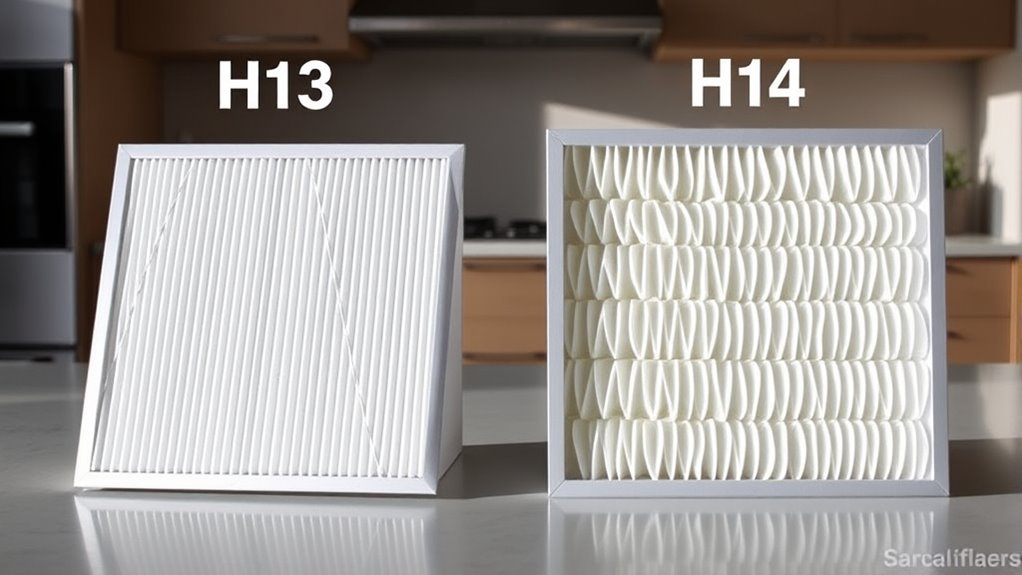
You’ll want to contemplate the cost differences between H13 and H14 filters, as prices can vary considerably. Availability may also impact your choice, since supply chains for these filters can face disruptions. Understanding these factors helps you make a practical decision that fits your budget and needs. Additionally, considering the effectiveness and safety of each filter type is essential for ensuring optimal air quality in your household.
Cost Differences and Pricing
Cost differences between H13 and H14 HEPA filters can markedly impact your decision-making process, especially when considering long-term expenses. An affordability analysis reveals that H13 filters are typically less inexpensive upfront, but H14 filters may require fewer replacements over time due to higher efficiency. Conducting a thorough price comparison helps you weigh initial costs against longevity and performance. Here’s a quick overview:
| Filter Type | Average Cost per Filter | Replacement Frequency |
|---|---|---|
| H13 | $50 – $70 | Every 6-12 months |
| H14 | $80 – $120 | Every 12-18 months |
Understanding these costs ensures you pick the best filter for your budget and air quality needs. Additionally, filter availability can vary based on supplier stock and regional demand, influencing overall costs.
Availability and Supply Chain
Availability and supply chain considerations play a crucial role in choosing between H13 and H14 HEPA filters. Supply chain disruptions can cause delays or shortages, especially if regional availability varies. H13 filters, being more common, tend to have a more reliable supply chain, making them easier to find in many areas. Conversely, H14 filters may face limited regional availability due to higher manufacturing complexity or fewer suppliers. During global disruptions or logistical issues, these differences become more noticeable, impacting your ability to purchase the right filter promptly. To avoid delays, it’s wise to check local suppliers and consider the stability of their supply chains when choosing between H13 and H14 HEPA filters. This ensures you stay protected without interruption. Additionally, understanding the manufacturing complexities involved can help you better anticipate potential supply issues.
Impact on Indoor Air Quality and Health Benefits

When it comes to improving indoor air quality, the choice between H13 and H14 HEPA filters can markedly influence health benefits. H14 filters trap even more microscopic particles, reducing allergens, bacteria, and viruses more effectively. This improves respiratory health and reduces allergy symptoms. However, be aware of air purification myths that overstate filter performance; real-world benefits depend on proper maintenance. Additionally, consider filter disposal tips to minimize environmental impact and prevent contamination. The table below compares key aspects:
| Feature | H13 HEPA | H14 HEPA | Health Impact |
|---|---|---|---|
| Filtration Efficiency | 99.95% particles ≥0.3 microns | 99.995% particles ≥0.3 microns | Better allergy and asthma relief |
| Particle Removal | Common in household purifiers | Higher-grade filtration | Reduced airborne pathogens |
| Environmental tips | Regular disposal in sealed bags | Proper disposal to prevent contamination | Enhanced overall indoor air quality |
Additionally, understanding the filtration standards can help consumers make more informed decisions about air purifier performance.
Compatibility With Different Household Purifier Models
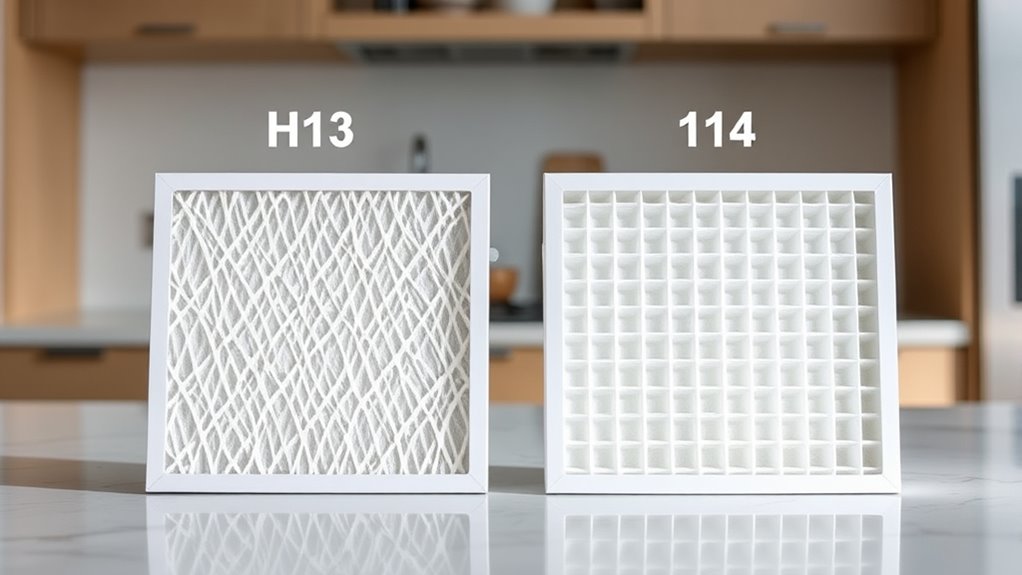
Choosing the right HEPA filter requires ensuring it fits your household purifier model, as compatibility varies widely among brands and units. Before purchasing, check the manufacturer’s specifications for filter replacement and installation compatibility. Some filters are designed for specific models, which means using an incompatible filter could hinder performance or damage your device. Measure your current filter or consult your purifier’s manual to confirm size and fit. Many brands offer compatibility charts or lists to simplify this process. Keep in mind that even minor differences in dimensions or connector types can prevent proper installation. Ensuring compatibility not only guarantees effective filtration but also avoids unnecessary delays or costs associated with returns or modifications. Always verify that the HEPA filter you choose aligns with your purifier’s requirements. Additionally, understanding filter specifications can help you select the most suitable option for optimal performance.
Choosing the Right HEPA Filter for Your Needs
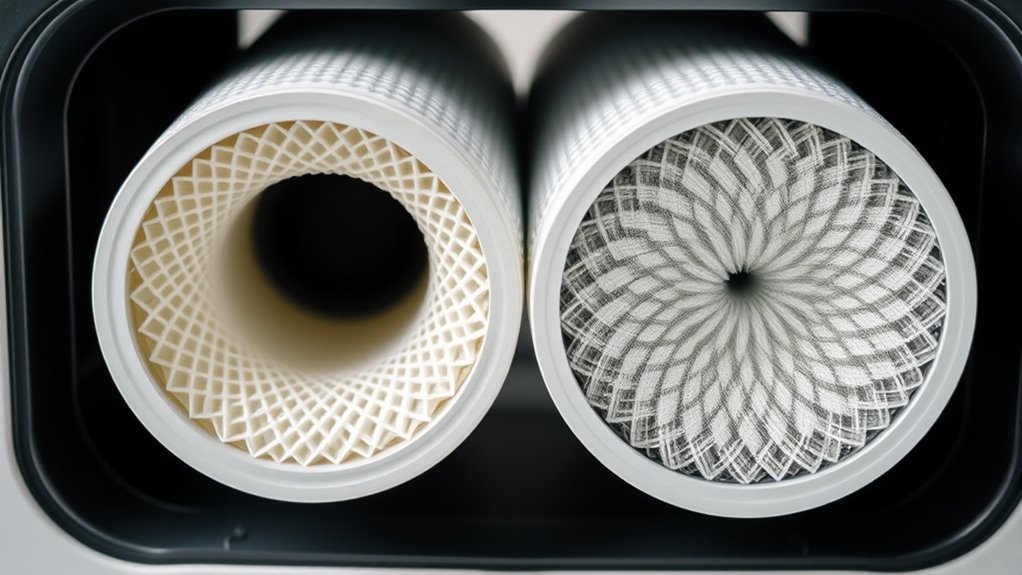
Selecting the right HEPA filter depends on your specific air quality needs and the environment you want to improve. If you need long-lasting filtration, consider filters with a longer filtration lifespan, which reduces the frequency of filter replacement and maintenance. H13 filters generally offer a good balance of efficiency and durability, making them suitable for continuous use. If your environment has higher levels of allergens or pollutants, opting for H14 filters might be beneficial, though they may require more frequent filter replacement due to their finer filtration. Assess your air quality concerns, budget, and how often you’re willing to replace filters to choose the best option. Properly selecting a filter guarantees excellent performance and cleaner air, tailored to your specific household needs.
Frequently Asked Questions
How Long Do H13 and H14 HEPA Filters Typically Last?
Your HEPA filter’s lifespan depends on usage and air quality, but generally, H13 and H14 filters last about 6 to 12 months. You should monitor the filter’s condition and replace it when it becomes visibly dirty or airflow decreases. Regular replacement is essential for peak performance, so maintaining a consistent replacement frequency ensures your purifier continues to effectively clean your indoor air.
Are H14 Filters More Eco-Friendly Than H13 Filters?
You might wonder if H14 filters are more eco-friendly than H13 ones. Generally, H14 filters use eco-friendly materials and may have lower energy consumption due to advanced design, reducing their environmental impact. However, the actual eco-friendliness depends on how they’re manufactured and disposed of. Choosing filters with sustainable materials and energy-efficient operation helps minimize your household’s ecological footprint, making H14 filters a slightly greener option in many cases.
Can H14 Filters Remove Viruses More Effectively Than H13 Filters?
Think of virus filtration as a finely tuned net catching tiny whispers of danger. H14 filters act like a super-advanced sieve, trapping more viruses than H13 filters, thanks to their higher particle removal efficiency. They excel at capturing even the smallest particles, making them more effective at removing viruses. So, yes, H14 filters are better suited for virus filtration, providing a safer environment by blocking more microscopic threats.
Do H14 Filters Require Specialized Installation Procedures?
You might wonder if H14 filters need specialized installation procedures. Generally, they don’t, but installation complexity depends on your purifier’s design. You should check compatibility considerations, as not all units fit H14 filters easily. Some models may require adjustments or specific steps to guarantee proper sealing and performance. Always follow the manufacturer’s instructions to avoid issues and maximize the filter’s effectiveness.
Are There Any Health Risks Associated With Improper Filter Maintenance?
Improper filter maintenance can pose health risks by reducing indoor air quality and allowing trapped pollutants to circulate. If you don’t replace or clean filters properly, you might release dust, allergens, or bacteria back into your home. Also, consider filter disposal concerns, as improper disposal can harm the environment. Regular maintenance guarantees your purifier works efficiently, keeps your indoor air safe, and minimizes health risks associated with contaminated filters.
Conclusion
Choosing between H13 and H14 filters is like selecting the perfect lens for your indoor haven. While both clear the air’s shadows, H14 offers a more refined view, capturing finer particles with gentle precision. Consider your needs, and let your purifier become a silent guardian, quietly transforming your space into a gust of fresh, crisp air. In this delicate dance of filtration, the right choice will help your home’s atmosphere feel lighter and more inviting.


